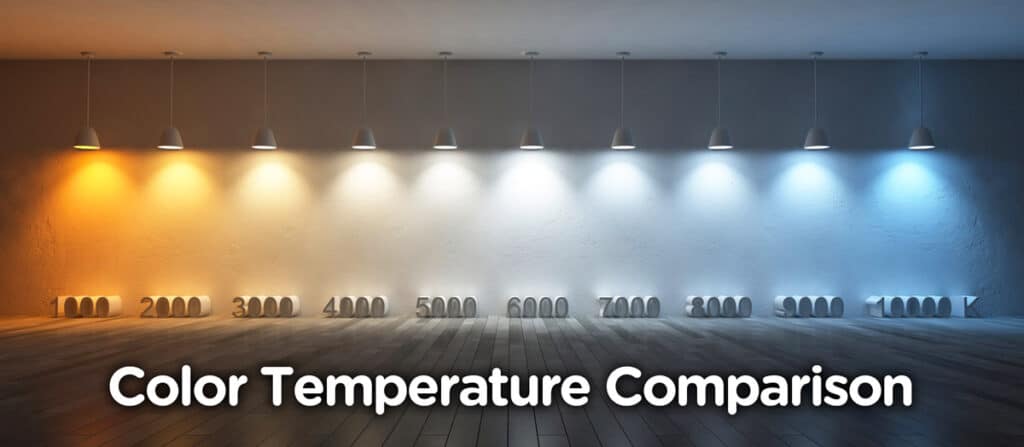Wondering what kind of light bulbs would best suit your home? Well, it can be overwhelming to figure out the many different terms used in modern lighting solutions.
However, it doesn’t have to be. You only have to know what you need to know. So in this article, we’ll be exploring the major differences between 4000k and 5000k lights to see how they compare based on various applications and home settings.
Table of Contents
4000k vs 5000k Light Bulb Overview

First, these two options are at the point in the Kelvin scale where lights start becoming more white than yellow. Briefly put, though, 4000k light bulbs are not as “cool” as the 5000K lights.
But don’t get this wrong. Of course, there are certain rules that go into the lighting game, but that shouldn’t keep you from having a color temperature you particularly like.
Color temperature is generally driven by personal preferences and overall application. What color temperature seems good to you may not necessarily be what someone else loves and vice versa.
In fact, the color temperatures are so close together between the 4000k and 5000k light bulbs and can be difficult to tell with the naked eye. But as you may have guessed, 4000k is a bit subtle, and slightly less “cool” compared to 5000k.
As such, 4000k lights are quite universal than 5000k and if you are on the fence, we would suggest leaning towards opting for a 4000k color temperature.
The 5000k is considered great for kitchen applications or task lighting areas- although some people might see it as too white and sterile. Again, it all comes down to lots of variables and applications.
4000K vs 5000k Lighting: What’s the Difference?
Unless you’re using a photometer, naked eyes can barely effectively see the difference between LED 4000k vs 5000 lights.
Both options are too close to each other in the Kelvin scale for the human eye to differentiate significantly. Still, after close observation, you will start to notice what sets them apart.
As per the Kelvin scale, 4000k lights are when the lights start becoming more white than yellow. Therefore, even though the 4000k lights look perfectly white, they still do have a yellow tinge, which makes them easier on the eyes. Perhaps this is the main reason why they’re so common in office and retail premises.
Kook lights, on the other hand, fall at the point where there’s almost no visible yellow light. At this point, the lights become neutral, or almost perfectly white. This type of light is considered ideal for people who want to see the actual colors of objects, which is why they’re often found in art galleries and showrooms.
So which is brighter? 4000k or 5000k Lights
Is 5000k brighter compared to 4000k? Well, that will depend on your individual preferences and the application the lights are subjected to. But based on the overall Kelvin scale, 4000k is not too bright. For that reason, they are considered best for many bathrooms, kitchens, and garages.
The various applications where you might want to reconsider include closets and bedrooms. Again, this is a quite subjective opinion given that people tend to have different tastes and preferences. But unless you have white cabinetry, 5000k lights’ color temperatures can appear excessively bright and trigger a medical feel to a room.
That said, both 4000k and 5000k can be used in various wattages. For instance, a 60w and a 100w LED bulb can be used in 4000k or 5000k. The lumen, which is the basic measurement of brightness, will be different on each, however.
That means if you get a 5000k and a 4000k light bulb, both having 100 lumens, they can light up the same area equally. Therefore, assuming that a 5000k bulb is brighter compared to a 4000k isn’t really accurate. It might only look so simply because the latter gives off a warmer color.
If you want to light a larger space, you will need a bulb that has enough lumens. You can determine how many lumens a certain light bulb has by checking on the label. You could also find the color and other relevant information there.
5000k vs 4000k for Kitchens

The most suitable LED light color temperature will depend on the kitchen design and cabinetry color. Both 5000k and 4000k can each look great though. 5000K lights are considered ideal for kitchens with cool white cabinetry and a modern to transitional design.
On the other hand, 4000k lights start to cross over into a warmer tone and they tend to pink out white cabinets. In the event that you have a darker kitchen with conventional wood color cabinets, a 3000k light would be an easy recommendation.
You might also be thinking about getting an LED strip light with a 4000k color temperature, and as we mentioned, this option can be an ideal color for a variety of applications due to its versatility. Strip lights are most suitable for under cabinets in kitchens, laundry rooms, bathrooms, and garages.
Conclusion
Simply put, the main difference between 4000k vs 5000k light is their color temperatures. 4000k LED light bulbs are a bit warmer than 5000k. However, it’s hard to discern this difference with an untrained eye. You’ll notice after a while with keen observation.
As for the color temperature, this is simply the rating a color gets on the Kelvin scale which goes from 1000k to 10000k. That means the higher the Kelvin scale, the whiter and blue a light gets, and the lower the Kelvin scale goes, the more yellow, orange, and red a light gets.
Both the 4000k and 5000k lights are already at the point of the Kelvin scale where lights tend to get more white than yellow. Otherwise, we all have unique preferences and this is just a guide to keep you on track. It’s perfectly fine to steer clear of the norm and go with what best suits your home.


